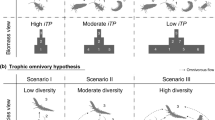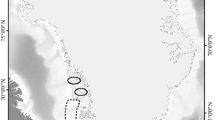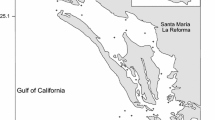Abstract
Estimating trophic structures is a common approach used to retrieve information regarding energy pathways, predation, and competition in complex ecosystems. The application of amino acid (AA) compound-specific nitrogen (N) isotope analysis (CSIA) is a relatively new method used to estimate trophic position (TP) and feeding relationships in diverse organisms. Here, we conducted the first meta-analysis of δ15N AA values from measurements of 359 marine species covering four trophic levels, and compared TP estimates from AA-CSIA to literature values derived from food items, gut or stomach content analysis. We tested whether the AA trophic enrichment factor (TEF), or the 15N enrichment among different individual AAs is constant across trophic levels and whether inclusion of δ15N values from multiple AAs improves TP estimation. For the TEF of glutamic acid relative to phenylalanine (Phe) we found an average value of 6.6 ‰ across all taxa, which is significantly lower than the commonly applied 7.6 ‰. We found that organism feeding ecology influences TEF values of several trophic AAs relative to Phe, with significantly higher TEF values for herbivores compared to omnivores and carnivores, while TEF values were also significantly lower for animals excreting urea compared to ammonium. Based on the comparison of multiple model structures using the metadata of δ15N AA values we show that increasing the number of AAs in principle improves precision in TP estimation. This meta-analysis clarifies the advantages and limitations of using individual δ15N AA values as tools in trophic ecology and provides a guideline for the future application of AA-CSIA to food web studies.




Similar content being viewed by others
References
Arthur KE, Kelez S, Larsen T, Choy CA, Popp BN (2014) Tracing the biosynthetic source of essential amino acids in marine turtles using δ13C fingerprints. Ecology 95:1285–1293
Baker R, Buckland A, Sheaves M (2014) Fish gut content analysis: robust measures of diet composition. Fish Fish 15:170–177
Bloomfield AL, Elsdon TS, Walther BD, Gier EJ, Gillanders BM (2011) Temperature and diet affect carbon and nitrogen isotopes of fish muscle: can amino acid nitrogen isotopes explain effects? J Exp Mar Biol Ecol 399:48–59. doi:10.1016/j.jembe.2011.01.015
Boecklen WJ, Yarnes CT, Cook BA, James AC (2011) On the use of stable isotopes in trophic ecology. Annu Rev Ecol Evol Syst 42:411–440. doi:10.1146/annurev-ecolsys-102209-144726
Bradley CJ, Madigan DJ, Block BA, Popp BN (2014) Amino acid isotope incorporation and enrichment factors in Pacific bluefin tuna, Thunnus orientalis. PloS One 9:e85818
Chikaraishi Y, Kashiyama Y, Ogawa NO, Kitazato H, Ohkouchi N (2007) Metabolic control of nitrogen isotope composition of amino acids in macroalgae and gastropods: implications for aquatic food web studies. Mar Ecol Prog Ser 342:85–90
Chikaraishi Y et al (2009) Determination of aquatic food-web structure based on compound-specific nitrogen isotopic composition of amino acids. Limnol Oceanogr Meth 7:740–750
Chikaraishi Y, Ogawa N, Ohkouchi N (2010) Further evaluation of the trophic level estimation based on nitrogen isotopic composition of amino acids. Earth, life, and isotopes. Kyoto University Press, Kyoto, pp 37–51
Chikaraishi Y et al (2014) High-resolution food webs based on nitrogen isotopic composition of amino acids. Ecol Evol 4(12):2423–2449
Choy CA et al (2012) Global trophic position comparison of two dominant mesopelagic fish families (Myctophidae, Stomiidae) using amino acid nitrogen isotopic analyses. PLoS One 7:e50133. doi:10.1371/journal.pone.0050133
Cortés E (1997) A critical review of methods of studying fish feeding based on analysis of stomach contents: application to elasmobranch fishes. Can J Fish Aquat Sci 54:726–738
Dale JJ, Wallsgrove NJ, Popp BN, Holland KN (2011) Nursery habitat use and foraging ecology of the brown stingray Dasyatis lata determined from stomach contents, bulk and amino acid stable isotopes. Mar Ecol Prog Ser. doi:10.3354/meps09171
Dalerum F, Angerbjorn A (2005) Resolving temporal variation in vertebrate diets using naturally occurring stable isotopes. Oecologia 144:647–658. doi:10.1007/s00442-005-0118-0
Décima M, Landry MR, Popp BN (2013) Environmental perturbation effects on baseline δ15N values and zooplankton trophic flexibility in the southern California Current Ecosystem. Limnol Oceanogr 58:624–634
Downs EE, Popp BN, Holl CM (2014) Nitrogen isotope fractionation and amino acid turnover rates in the Pacific white shrimp Litopenaeus vannamei. Mar Ecol Prog Ser 516:239–250
Froese R, Pauly D (2012) Fishbase http://www.fishbase.org
Gaye-Siessegger J, Focken U, Abel H, Becker K (2004) Individual protein balance strongly influences δ15N and δ13C values in Nile tilapia, Oreochromis niloticus. Naturwissenschaften 91:90–93. doi:10.1007/s00114-003-0496-2
Germain LR, Koch PL, Harvey J, McCarthy MD (2013) Nitrogen isotope fractionation in amino acids from harbor seals: implications for compound-specific trophic position calculations. Mar Ecol Prog Ser 482:265–277
Graham BS, Grubbs D, Holland K, Popp BN (2007) A rapid ontogenetic shift in the diet of juvenile yellowfin tuna from Hawaii. Mar Biol 150:647–658
Grey J, Jones RI, Sleep D (2001) Seasonal changes in the importance of the source of organic matter to the diet of zooplankton in Loch Ness, as indicated by stable isotope analysis. Limnol Oceanogr 46:505–513
Gutiérrez-Rodrıguez A, Décima M, Popp BN, Landry MR (2014) Isotopic invisibility of protozoan trophic steps in marine food webs. Limnol Oceanogr 59:1590–1598
Hannides CCS, Popp BN, Landry MR, Graham BS (2009) Quantification of zooplankton trophic position in the North Pacific subtropical gyre using stable nitrogen isotopes. Limnol Oceanogr 54:50
Hayes J, Freeman KH, Popp BN, Hoham CH (1990) Compound-specific isotopic analyses: a novel tool for reconstruction of ancient biogeochemical processes. Org Geochem 16:1115–1128
Hoen DK, Kim SL, Hussey NE, Wallsgrove NJ, Drazen JC, Popp BN (2014) Amino acid δ15N trophic enrichment factors of four large carnivorous fishes. J Exp Mar Biol Ecol 453:76–83
Hynes H (1950) The food of fresh-water sticklebacks (Gasterosteus aculeatus and Pygosteus pungitius), with a review of methods used in studies of the food of fishes. J Animal Ecol 36-58
Hyslop E (1980) Stomach contents analysis—a review of methods and their application. J Fish Biol 17:411–429
Ishikawa NF et al (2014) Stable nitrogen isotopic composition of amino acids reveals food web structure in stream ecosystems. Oecologia 175(3):1–12
Lorrain A et al (2009) Nitrogen and carbon isotope values of individual amino acids: a tool to study foraging ecology of penguins in the Southern Ocean. Mar Ecol Prog Ser 391:293–306. doi:10.3354/meps08215
Lorrain A et al (2014) Nitrogen isotopic baselines and implications for estimating foraging habitat and trophic position of yellowfin tuna in the Indian and Pacific Oceans. Deep Sea Res Part II Topical Stud Oceanogr 113:188–198. doi.10.1016/j.dsr2.2014.02.003
Mackenzie KM et al (2011) Locations of marine animals revealed by carbon isotopes. Sci Rep 1:21. doi:10.1038/srep00021
Madigan DJ et al (2014) Reconstructing transoceanic migration patterns of Pacific bluefin tuna using a chemical tracer toolbox. Ecology 95:1674–1683
Maeda T et al (2012) Algivore or phototroph? Plakobranchus ocellatus (Gastropoda) continuously acquires kleptoplasts and nutrition from multiple algal species in nature. PLoS One 7:e42024
Martínez del Rio C, Wolf BO (2005) Mass-balance models for animal isotopic ecology. In: Physiological and ecological adaptations to feeding in vertebrates pp 141–174
Martínez del Rio C, Wolf N, Carleton SA, Gannes LZ (2009) Isotopic ecology ten years after a call for more laboratory experiments. Biol Rev Camb Philos Soc 84:91–111. doi:10.1111/j.1469-185X.2008.00064.x
McCarthy MD, Benner R, Lee C, Fogel ML (2007) Amino acid nitrogen isotopic fractionation patterns as indicators of heterotrophy in plankton, particulate, and dissolved organic matter. Geochim Cosmochim Acta 71:4727–4744. doi:10.1016/j.gca.2007.06.061
McCarthy MD, Lehman J, Kudela R (2013) Compound-specific amino acid δ15N patterns in marine algae: tracer potential for cyanobacterial vs. eukaryotic organic nitrogen sources in the ocean. Geochim Cosmochim Acta 103:104–120
McClelland JW, Montoya JP (2002) Trophic relationships and the nitrogen isotopic composition of amino acids in plankton. Ecology 83:2173–2180. doi:10.2307/3072049
McClelland JW, Holl CM, Montoya JP (2003) Relating low δ15N values of zooplankton to N2-fixation in the tropical North Atlantic: insights provided by stable isotope ratios of amino acids. Deep Sea Res Part I 50:849–861. doi:10.1016/s0967-0637(03)00073-6
McCutchan JH, Lewis WM, Kendall C, McGrath CC (2003) Variation in trophic shift for stable isotope ratios of carbon, nitrogen, and sulfur. Oikos 102:378–390
McMahon KW, Fogel ML, Elsdon TS, Thorrold SR (2010) Carbon isotope fractionation of amino acids in fish muscle reflects biosynthesis and isotopic routing from dietary protein. J Animal Ecol 79:1132–1141. doi:10.1111/j.1365-2656.2010.01722.x
McMahon KW, Hamady LL, Thorrold SR (2013) A review of ecogeochemistry approaches to estimating movements of marine animals. Limnol Oceanogr 58:697–714
Newsome SD, Fogel ML, Kelly L, del Rio CM (2011) Contributions of direct incorporation from diet and microbial amino acids to protein synthesis in Nile tilapia. Funct Ecol 25:1051–1062
O’Malley JM, Drazen JC, Popp BN, Gier E, Toonen RJ (2012) Spatial variability in growth and prey availability of lobsters in the northwestern Hawaiian Islands. Mar Ecol Prog Ser 449:211–220
Olson RJ et al (2010) Food-web inferences of stable isotope spatial patterns in copepods and yellowfin tuna in the pelagic eastern Pacific Ocean. Prog Oceanogr 86:124–138
Popp BN et al (2007) Insight into the trophic ecology of yellowfin tuna Thunnus albacares, from compound-specific nitrogen isotope analysis of proteinaceous amino acids. Terr Ecol 1:173–190. doi:10.1016/s1936-7961(07)01012-3
Post DM (2002) Using stable isotopes to estimate trophic position: models, methods, and assumptions. Ecology 83:703–718
R Development Core Team (2014) R: a language and environment for statistical computing. R Foundation for Statistical Computing, Vienna
Rindorf A, Lewy P (2004) Bias in estimating food consumption of fish by stomach-content analysis. Can J Fish Aquat Sci 61:2487–2498
Rolff C (2000) Seasonal variation in δ13C and δ15N of size-fractionated plankton at a coastal station in the northern Baltic proper. Mar Ecol Prog Ser 203:47–65. doi:10.3354/meps203047
Ruiz-Cooley RI, Ballance LT, McCarthy MD (2013) Range expansion of the jumbo squid in the NE Pacific: δ15N decrypts multiple origins, migration and habitat use. PloS One 8:e59651
Schmidt K, McClelland JW, Mente E, Montoya JP, Atkinson A, Voss M (2004) Trophic-level interpretation based on δ15N values: implications of tissue-specific fractionation and amino acid composition. Mar Ecol Progr Ser 266:43–58
Seminoff JA et al (2012) Stable isotope tracking of endangered sea turtles: validation with satellite telemetry and δ15n analysis of amino acids. PLoS One 7:e37403
Sherwood OA, Lehmann MF, Schubert CJ, Scott DB, McCarthy MD (2011) Nutrient regime shift in the western North Atlantic indicated by compound-specific δ15N of deep-sea gorgonian corals. Proc Natl Acad Sci 108:1011–1015. doi:10.1073/pnas.1004904108
Trueman C, MacKenzie K, Palmer M (2012) Identifying migrations in marine fishes through stable-isotope analysis. J Fish Biol 81:826–847
Vander Zanden HB et al (2013) Trophic ecology of a green turtle breeding population. Mar Ecol Prog Ser 476:237–249
Vanderklift MA, Ponsard S (2003) Sources of variation in consumer-diet d15N enrichment: a meta-analysis. Oecologia 136:169–182. doi:10.1007/s00442-003-1270-z
Vokhshoori NL, McCarthy MD (2014) Compound-specific δ15N amino acid measurements in littoral mussels in the California upwelling ecosystem: a new approach to generating baseline δ15N isoscapes for coastal ecosystems. PLoS One 9:e98087
Warton DI, Wright IJ, Falster DS, Westoby M (2006) Bivariate line-fitting methods for allometry. Biol Rev Camb Philos Soc 81:259–291. doi:10.1017/S1464793106007007
Warton DI, Duursma RA, Falster DS, Taskinen S (2012) smatr 3–an R package for estimation and inference about allometric lines. Methods Ecol Evol 3:257–259
Acknowledgments
This study received financial support from the German Science Foundation (DFG) under the project number WI 2726/2-1. This work was also partially supported by the National Science Foundation under grant number OCE-1041329 (to B. N. P. and Jeffrey C. Drazen). This is SOEST contribution number 9284. The authors would like to thank Alfred Burian, Karen Arthur, Yoshito Chikaraishi and one anonymous reviewer for constructive comments that helped improve the manuscript. We are thankful to authors of previous publications of marine δ15N AA values which made data compilation for this manuscript possible. Any opinions, findings, and conclusions or recommendations expressed in this material are those of the authors and do not necessarily reflect the views of our funding sources.
Author information
Authors and Affiliations
Corresponding author
Additional information
Communicated by Ulrich Sommer.
Electronic supplementary material
Below is the link to the electronic supplementary material.
442_2015_3305_MOESM1_ESM.pdf
Appendix A: overview of all compiled metadata. Appendix B: figures and correlation coefficients of additional trophic AAs δ15N values relative to δ15NPhe values. Appendix C: model input parameters. Appendix D: TEF values for CH4N2O- and NH+ 4-excreting organisms. Supplementary material 1 (PDF 2182 kb)
Rights and permissions
About this article
Cite this article
Nielsen, J.M., Popp, B.N. & Winder, M. Meta-analysis of amino acid stable nitrogen isotope ratios for estimating trophic position in marine organisms. Oecologia 178, 631–642 (2015). https://doi.org/10.1007/s00442-015-3305-7
Received:
Accepted:
Published:
Issue Date:
DOI: https://doi.org/10.1007/s00442-015-3305-7




